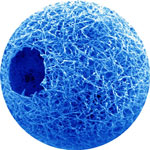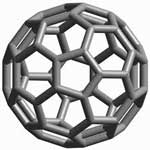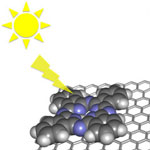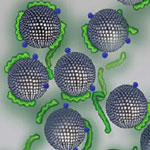Showing Spotlights 1657 - 1664 of 2780 in category All (newest first):
 In the wake of the BP oil spill in the Gulf of Mexico we published a general overview of the wide variety of nanomaterials and nanotechnologies that offer significant promise for oil spill cleanup and recovery. One problem with many existing solutions though is that they are one-offs, i.e. one they absorb oil they can't be re-used and need to be disposed of (which could in turn create secondary pollution effects). Ideally, any oil absorbent material used during ocean oil spills should be reusable and with special wettability that could controllably capture and release oil pollution repeatedly. Addressing this issue, researchers have now created an underwater water/solid interface inspired by fish scales. The surface of this new material shows superamphiphobicity in air and superoleophilicity under water, allowing it to be repeatedly used to capture and collect oil droplets in water.
In the wake of the BP oil spill in the Gulf of Mexico we published a general overview of the wide variety of nanomaterials and nanotechnologies that offer significant promise for oil spill cleanup and recovery. One problem with many existing solutions though is that they are one-offs, i.e. one they absorb oil they can't be re-used and need to be disposed of (which could in turn create secondary pollution effects). Ideally, any oil absorbent material used during ocean oil spills should be reusable and with special wettability that could controllably capture and release oil pollution repeatedly. Addressing this issue, researchers have now created an underwater water/solid interface inspired by fish scales. The surface of this new material shows superamphiphobicity in air and superoleophilicity under water, allowing it to be repeatedly used to capture and collect oil droplets in water.
May 9th, 2011
 The potential use of antimicrobial surface coatings ranges from medicine, where medical device infection is associated with significant healthcare costs, to the construction industry and the food packaging industry. Thin films containing silver nanoparticles have been seen as promising candidate coatings. Silver is known as one of the oldest antimicrobial agents. Silver ions are thought to inhibit bacterial enzymes and bind to DNA. Silver nanomaterials have been used effectively against different bacteria, fungi and viruses. Using something like an advanced form of a rubber stamp, scientists have now developed a way to adhere an ultra-thin (just a few molecules thick) antibacterial coating to a wound. The "stamped" area shows bactericidal activity for at least 48 hours.
The potential use of antimicrobial surface coatings ranges from medicine, where medical device infection is associated with significant healthcare costs, to the construction industry and the food packaging industry. Thin films containing silver nanoparticles have been seen as promising candidate coatings. Silver is known as one of the oldest antimicrobial agents. Silver ions are thought to inhibit bacterial enzymes and bind to DNA. Silver nanomaterials have been used effectively against different bacteria, fungi and viruses. Using something like an advanced form of a rubber stamp, scientists have now developed a way to adhere an ultra-thin (just a few molecules thick) antibacterial coating to a wound. The "stamped" area shows bactericidal activity for at least 48 hours.
May 5th, 2011
 Damaged articular cartilages, like the ones found in the knee joint, ordinarily demonstrate a very limited capability for self-healing. Functional restoration of diseased or damaged articular cartilage is a major clinical challenge. There have been a number of successful approaches to tissue engineered cartilage, including the use of natural and synthetic biomaterial scaffolds. Although recent progress has been made in engineering cartilage of various shapes and sizes for cosmetic purposes, current treatments for cartilage repair are less than satisfactory, and rarely restore full function or return the tissue to its native state. Researchers have now developed nanofibrous hollow microspheres self-assembled from star-shaped biodegradable polymers as an injectable cell carrier. When the spheres are injected with cells into wounds, these spheres biodegrade, but the cells live on to form new tissue.
Damaged articular cartilages, like the ones found in the knee joint, ordinarily demonstrate a very limited capability for self-healing. Functional restoration of diseased or damaged articular cartilage is a major clinical challenge. There have been a number of successful approaches to tissue engineered cartilage, including the use of natural and synthetic biomaterial scaffolds. Although recent progress has been made in engineering cartilage of various shapes and sizes for cosmetic purposes, current treatments for cartilage repair are less than satisfactory, and rarely restore full function or return the tissue to its native state. Researchers have now developed nanofibrous hollow microspheres self-assembled from star-shaped biodegradable polymers as an injectable cell carrier. When the spheres are injected with cells into wounds, these spheres biodegrade, but the cells live on to form new tissue.
May 4th, 2011
 Glues adhere to solid materials via a multitude of fundamental physical or chemical interactions. Either chemical reaction times or solvent evaporation rates determine the point in time, when this interaction sets in and fixes the object to be glued. Electric potential has been used to attract polymers continuously to an electrode surface and to toggle molecules between states for a molecular switch. If you wanted to create electric glue, you would need to be able to control the interaction of a polymer and an electrode surface reversibly, thus creating a nanoscale system with electrochemically controlled adhesion. A research team now describes how Coulomb forces between polymers and surfaces may be measured, controlled, and manipulated.
Glues adhere to solid materials via a multitude of fundamental physical or chemical interactions. Either chemical reaction times or solvent evaporation rates determine the point in time, when this interaction sets in and fixes the object to be glued. Electric potential has been used to attract polymers continuously to an electrode surface and to toggle molecules between states for a molecular switch. If you wanted to create electric glue, you would need to be able to control the interaction of a polymer and an electrode surface reversibly, thus creating a nanoscale system with electrochemically controlled adhesion. A research team now describes how Coulomb forces between polymers and surfaces may be measured, controlled, and manipulated.
May 3rd, 2011
 Heparin is widely used as an anti-coagulant to prevent the formation of blood clots. This naturally occurring biological molecule is commonly used during surgery for blood thinning. At the end of surgery, heparin has to be removed in order to allow the blood to clot again - this is currently done using a protein called protamine, the only clinically approved heparin binder. Unfortunately, protamine can cause severe allergic reactions in a number of patients. Researchers at the University of York have now developed a synthetic molecule which is capable of binding heparin just as effectively as protamine. The team's approach may eventually be useful for developing protamine replacements.
Heparin is widely used as an anti-coagulant to prevent the formation of blood clots. This naturally occurring biological molecule is commonly used during surgery for blood thinning. At the end of surgery, heparin has to be removed in order to allow the blood to clot again - this is currently done using a protein called protamine, the only clinically approved heparin binder. Unfortunately, protamine can cause severe allergic reactions in a number of patients. Researchers at the University of York have now developed a synthetic molecule which is capable of binding heparin just as effectively as protamine. The team's approach may eventually be useful for developing protamine replacements.
May 2nd, 2011
 There is a general perception that nanotechnologies will have a significant impact on developing 'green' and 'clean' technologies with considerable environmental benefits. However, the environmental footprint created by today's nanomanufacturing technologies are conflicting with the general perception that nanotechnology environmentally benign. It actually appears that certain nanomaterial production technologies are quite dirty and also have a considerable energy footprint. Determining the full environmental impact of nanomaterials requires a full life cycle assessment. A recent paper takes a look at the material and energy intensity of fullerene production. It finds that the embodied energy of all fullerenes are an order of magnitude higher than most common chemicals.
There is a general perception that nanotechnologies will have a significant impact on developing 'green' and 'clean' technologies with considerable environmental benefits. However, the environmental footprint created by today's nanomanufacturing technologies are conflicting with the general perception that nanotechnology environmentally benign. It actually appears that certain nanomaterial production technologies are quite dirty and also have a considerable energy footprint. Determining the full environmental impact of nanomaterials requires a full life cycle assessment. A recent paper takes a look at the material and energy intensity of fullerene production. It finds that the embodied energy of all fullerenes are an order of magnitude higher than most common chemicals.
Apr 20th, 2011
 The extremely high electron mobility of graphene - under ideal conditions electrons move through it with roughly 100 times the mobility they have in silicon - combined with its superior strength and the fact that it is nearly transparent (2.3 % of light is absorbed; 97.7 % transmitted), make it an ideal candidate for photovoltaic applications. Recent research suggests, though, that doping is a necessity to harvest the full potential of graphene. The challenge then for researchers is to find suitable fabrication techniques for high-quality graphene flakes that exhibit high charge mobilities. Researchers now present a chemical approach towards non-covalently functionalized graphene, which is generated from vastly available and low-priced natural graphite.
The extremely high electron mobility of graphene - under ideal conditions electrons move through it with roughly 100 times the mobility they have in silicon - combined with its superior strength and the fact that it is nearly transparent (2.3 % of light is absorbed; 97.7 % transmitted), make it an ideal candidate for photovoltaic applications. Recent research suggests, though, that doping is a necessity to harvest the full potential of graphene. The challenge then for researchers is to find suitable fabrication techniques for high-quality graphene flakes that exhibit high charge mobilities. Researchers now present a chemical approach towards non-covalently functionalized graphene, which is generated from vastly available and low-priced natural graphite.
Apr 19th, 2011
 Ink-jet printing of metal nanoparticles for conductive metal patterns has attracted great interest as an alternative to expensive fabrication techniques like vapor deposition. The bulk of the research in this area focuses on printing metal nanoparticle suspensions (metallic ink) for metallization. Printing conductive features by metallic nanoparticle inks must be followed by an additional step of sintering, usually achieved by heating to elevated temperatures. In this step, the nanoparticles composing the pattern will coalesce to form a continuous electrical contact. In new work, researchers have now demonstrated a new conductive ink that won't require a post printing sintering step. It is achieved by the addition of a latent sintering agent that gets into action after the printing step. Once the solvent evaporates, the sintering agent concentration increases, leading to the spontaneous sintering of the nanoparticles.
Ink-jet printing of metal nanoparticles for conductive metal patterns has attracted great interest as an alternative to expensive fabrication techniques like vapor deposition. The bulk of the research in this area focuses on printing metal nanoparticle suspensions (metallic ink) for metallization. Printing conductive features by metallic nanoparticle inks must be followed by an additional step of sintering, usually achieved by heating to elevated temperatures. In this step, the nanoparticles composing the pattern will coalesce to form a continuous electrical contact. In new work, researchers have now demonstrated a new conductive ink that won't require a post printing sintering step. It is achieved by the addition of a latent sintering agent that gets into action after the printing step. Once the solvent evaporates, the sintering agent concentration increases, leading to the spontaneous sintering of the nanoparticles.
Apr 18th, 2011
 In the wake of the BP oil spill in the Gulf of Mexico we published a general overview of the wide variety of nanomaterials and nanotechnologies that offer significant promise for oil spill cleanup and recovery. One problem with many existing solutions though is that they are one-offs, i.e. one they absorb oil they can't be re-used and need to be disposed of (which could in turn create secondary pollution effects). Ideally, any oil absorbent material used during ocean oil spills should be reusable and with special wettability that could controllably capture and release oil pollution repeatedly. Addressing this issue, researchers have now created an underwater water/solid interface inspired by fish scales. The surface of this new material shows superamphiphobicity in air and superoleophilicity under water, allowing it to be repeatedly used to capture and collect oil droplets in water.
In the wake of the BP oil spill in the Gulf of Mexico we published a general overview of the wide variety of nanomaterials and nanotechnologies that offer significant promise for oil spill cleanup and recovery. One problem with many existing solutions though is that they are one-offs, i.e. one they absorb oil they can't be re-used and need to be disposed of (which could in turn create secondary pollution effects). Ideally, any oil absorbent material used during ocean oil spills should be reusable and with special wettability that could controllably capture and release oil pollution repeatedly. Addressing this issue, researchers have now created an underwater water/solid interface inspired by fish scales. The surface of this new material shows superamphiphobicity in air and superoleophilicity under water, allowing it to be repeatedly used to capture and collect oil droplets in water.
 Subscribe to our Nanotechnology Spotlight feed
Subscribe to our Nanotechnology Spotlight feed





